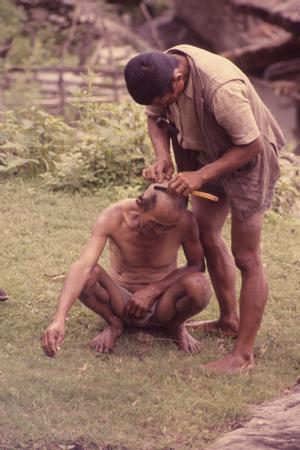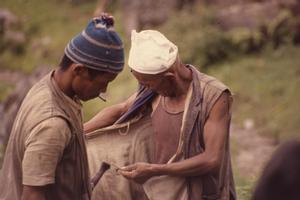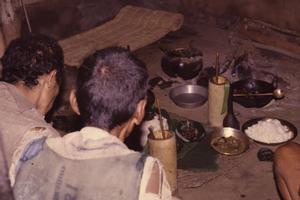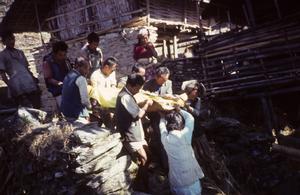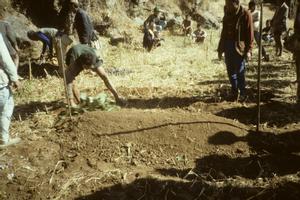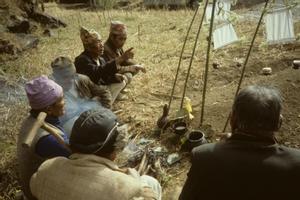Mewahang funeral
Among the Mewahang, as elsewhere, the death of a clan member is an event that, after the actual burial of the deceased, ushers in a period of impurity and danger for the latter's near and more distant agnatic relatives. In particular, there is a strict the taboo against the consumption of oil and salt that all members of the local clan are supposed to observe at the death of a fellow clansman. The burial itself and the rites associated with it, as well as the ritual discontinuity of the period of impurity - all of this is “work” in a more or less physical sense. But this “work” cannot be managed by the agnatic relatives alone; it requires the help of the affinal kin (in-laws).
When the dead person is put on its final journey to the grave, this rite is called lam ti:ma (Nep. bāṭo laune) 'guiding away', which is done by an elder in the role of nakchong. The relatives and neighbours from the vicinity come to pay their last homage: each household is expected to bring one wooden container of millet beer, from which a few drops are "fed" to the dead person.
After helpers have prepared the grave on a field below the house, the closer relatives of the deceased and all the other mourners (Nep. malāmi) assemble for the procession which takes the corpse down to its last resting place. The procession is headed by men who fall into the category of “son-in-law”. The grave is circled three times in anti-clockwise direction, and before the corpse is laid into the stone-coffin a fowl is killed by hitting its head on the stone plate. It is thrown away and may not be eaten: clearly this is not an ordinary sacrifice. The dead person is bedded in the coffin together with food and drink, some money, and personal belongings, such as the curved knife (Nep. khukuri) of a man, the sickle khurpā (Nep.) of a woman, the eating plate, etc. These belongings, to be used by the dead, are partly damaged, thus signalling the non-ordinary state of their owner.
The food offerings which had been carried by the “sons-in-law” are placed at the head end of the tomb, and after once again calling on the dead to go his or her proper path, everyone leaves the site to wash at the nearest watertap. Here the sons of the deceased get their heads shaved: this, again, is the task of the makcha, i.e. the "sons-in-law".
Eventually, after the period of mourning, the rites of purification mark the end of death pollution and for the majority of relatives all restrictions are lifted. The death spirit is sent on its proper path to become an ancestor. A focal symbol of this day are little white flags with chestnuts, a pair of which is prepared by the elders.
Gaenszle, Martin. 1999. The making of good ancestors: separation, transformation and exchange in Mewahang Rai funerary rites. In: Elisabeth Schömbucher and Claus Peter Zoller (eds.), Ways of dying: death and its meanings in South Asia. New Delhi: Manohar, pp. 49-67.


















